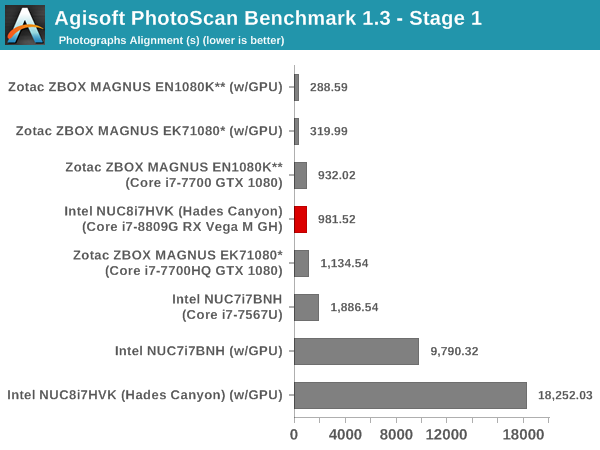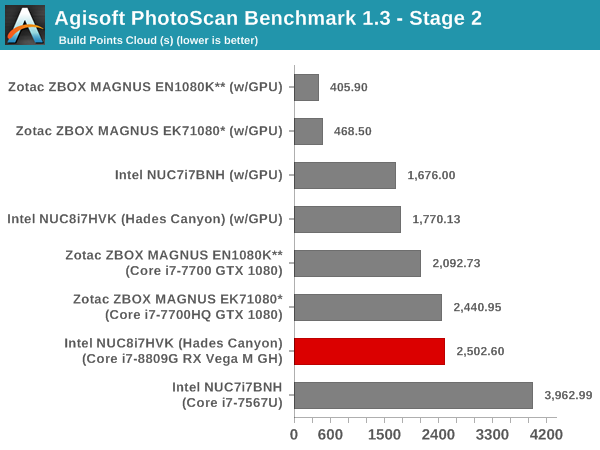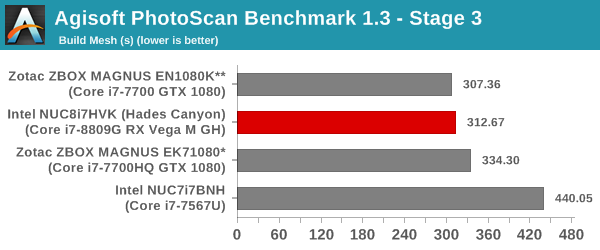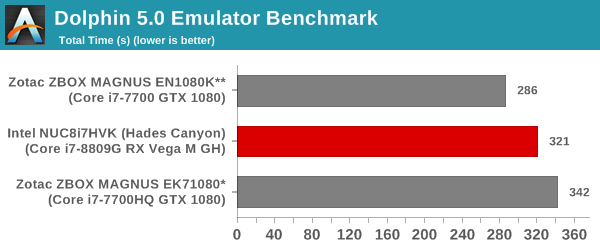The Intel NUC8i7HVK (Hades Canyon) Review: Kaby Lake-G Benchmarked
by Ganesh T S on March 29, 2018 1:00 PM ESTPerformance Metrics - II
In this section, we mainly look at benchmark modes in programs used on a day-to-day basis, i.e, application performance and not synthetic workloads.
x264 Benchmark
First off, we have some video encoding benchmarks courtesy of x264 HD Benchmark v5.0. This is simply a test of CPU performance. As expected, the Core i7-8809G with its 65W processor TDP slots closer to the Core i7-6700 and the Core i7-7700. Recent releases of the x264 benchmark can show even more impressive gains, as they make use of the latest and greatest features of the modern Intel processors.


7-Zip
7-Zip is a very effective and efficient compression program, often beating out OpenCL accelerated commercial programs in benchmarks even while using just the CPU power. 7-Zip has a benchmarking program that provides tons of details regarding the underlying CPU's efficiency. In this subsection, we are interested in the compression and decompression MIPS ratings when utilizing all the available threads. The performance order is similar to the one encountered in the x264 benchmark.


TrueCrypt
As businesses (and even home consumers) become more security conscious, the importance of encryption can't be overstated. CPUs supporting the AES-NI instruction for accelerating the encryption and decryption processes have become more widespread over the last few years. TrueCrypt, a popular open-source disk encryption program can take advantage of the AES-NI capabilities. The TrueCrypt internal benchmark provides some interesting cryptography-related numbers to ponder. In the graph below, we can get an idea of how fast a TrueCrypt volume would behave in the Intel NUC8i7HVK (Hades Canyon) and how it would compare with other select PCs. This is a purely CPU feature / clock speed based test.

Agisoft Photoscan
Agisoft PhotoScan is a commercial program that converts 2D images into 3D point maps, meshes and textures. The program designers sent us a command line version in order to evaluate the efficiency of various systems that go under our review scanner. The command line version has two benchmark modes, one using the CPU and the other using both the CPU and GPU (via OpenCL). We have been using an old version of the program with 50 photogaphs in our reviews till now. The updated benchmark (v1.3) now takes around 84 photographs and does four stages of computation:
- Stage 1: Align Photographs (capable of OpenCL acceleration)
- Stage 2: Build Point Cloud (capable of OpenCL acceleration)
- Stage 3: Build Mesh
- Stage 4: Build Textures
We record the time taken for each stage. Since various elements of the software are single threaded, others multithreaded, and some use GPUs, it is interesting to record the effects of CPU generations, speeds, number of cores, DRAM parameters and the GPU using this software.
The GPU-enabled numbers for Stage 1 and 2 below are with the use of the Intel HD Graphics 630, since our benchmark version only supports use of the first enumerated GPU. Unfortunately, when we tried to disable the integrated GPU and use only the discrete GPU after changing the BIOS setting, the benchmark consistently crashed while starting the first stage itself.




Dolphin Emulator
Wrapping up our application benchmark numbers is the new Dolphin Emulator (v5) benchmark mode results. This is again a test of the CPU capabilities, and the Core i7-8809G slots inbetween the 45W TDP Core i7-7700HQ and the 65W Core i7-7700.











124 Comments
View All Comments
PeachNCream - Friday, March 30, 2018 - link
The price really is way too high right now compared to a laptop if your focus is gaming. If you need a LAN party portable box, a laptop is usually a better option anyway since the screen and keyboard aren't additional components you'll have to take with you. Because the NUC is so small, it lacks the upgrade advantages offered by a desktop form factor so you're basically dealing with an overpriced, screenless laptop. I'm all for the technology at the heart of the new NUC, but you're absolutely right that it needs to start at $600.bill44 - Thursday, March 29, 2018 - link
I was hoping so much from this machine, ready to buy, only to be disappointed.No Titan Ridge TB3 (DP 1.4)
No UHD-BD playback
TB3 not connected to CPU
UHS-1 only card reader, no UHS-II
Issues with storage bandwidth since Spectre/Meltdown issues, no in-silicon fix (I know, 2nd half 2018).
Disappointing WiFi speed, no BT 5, even if M.2 changed no aerial.
Hardware decoding/codec issues
etc.
When can we expect the next (fixed version) :)
cacnoff - Thursday, March 29, 2018 - link
Titan Ridge - not out yet.UHD-BD playback - doesn't work on nvidia either.
Point to ANY designs with TB3 connected to CPU.
repoman27 - Thursday, March 29, 2018 - link
Apple does this pretty regularly. But last I knew, everyone else had to go through the PCH due to Windows / UEFI limitations. Which is a bummer because of the additional latency and clear potential for bandwidth contention.Hifihedgehog - Thursday, March 29, 2018 - link
“We can actually see that the codec support from the Intel side is miles ahead of the Radeon's capabilities.”This is misinformed at best, and categorically false at worse. I have been using a Ryzen 5 2400G, on an ASRock AB350 Gaming-ITX/ac motherboard to drive an HDMI 2.0 4K display at 12-bit (yes, despite lacking formal certification, HDMI 2.0 works flawlessly on 300-series motherboards). I successfully can play back various hefty video material, including HEVC in the form of lossless MKV rips of my UHD Blu-rays, and VP9. Moreover, the color, deblocking, and scaling is far superior in terms of pure optical fidelity to the Intel Skull Canyon NUC’s hazy, unrefined hardware decoding solution. Also, I could go at length about the dropout and timing issues of Intel’s HD Graphics with various high-end AV receivers (Marantz, Denon, and Yamaha) that I have had (e.g. timing issues from their onboard DP-to-HDMI converters causing DAC and sound processing to operate in a compatibility mode with 16-bit sound depth). Suffice it to say, from an objective standpoint, Intel’s NUCs are utter trash, littered with issues, that fall far short from being serious home theater solutions.
garbagedisposal - Thursday, March 29, 2018 - link
" misinformed at best, and categorically false at worse"Yes, you are.
"HDMI 2.0 works flawlessly on 300-series motherboards"
Congrats on discovering the obvious. Nobody claimed otherwise
"successfully can play back various hefty video material, including HEVC"
So can intel, better and at lower power. Isn't it sad that the radeon can't do VP9 or netflix?
"color, deblocking, and scaling is far superior"
Sure. Everything just looks so wrong on intel. Certainly takes a special snowflake like you to notice, good job.
"Marantz, Denon, and Yamaha"
Nobody cares.
Rabid angry people like you are funny, do you really think anyone is going to read or care about your comment? Go away LOL
Hifihedgehog - Thursday, March 29, 2018 - link
Please be polite and less “rabid.” Thanks.Hifihedgehog - Thursday, March 29, 2018 - link
For anyone reading the post above, Vega can correctly decode VP9, hybrid or otherwise. What was posted above is incorrect.Hifihedgehog - Thursday, March 29, 2018 - link
“Congrats on discovering the obvious. Nobody claimed otherwise”This is also false. Many reviews online of the Ryzen Raven Ridge APUs claimed that HDMI 2.0 support was yet non-existent given that most motherboard manufacturers state only HDMI 1.4 for their 300-series AM4 boards. This concerned many users, but after thorough research and testing (see here: smallformfactor (dot) net /forum/threads/raven-ridge-hdmi-2-0-compatibility-1st-gen-am4-motherboard-test-request-megathread.6709/ ; I am the one who started the thread and led its discussion), it was concluded that all current motherboards work without limitations or issue regardless of the published specifications. I will also ignore the passive-aggressive sarcasm and sentiment laced in-between the lines from the “Congrats” to the “LOL.” Please be less rabid and angry, and more people will take your seriously.
ganeshts - Thursday, March 29, 2018 - link
The Radeon GPU CAN NOT do VP9 Profile 2 - so you will NEVER get YouTube HDR on the. No PAVP. QuickSync ecosystem support is way ahead of Radeon VCE. So, tell me why I am wrong in saying that the Intel iGPU is miles ahead of the Radeon Vega ? Any neutral industry observer can see that I am completely justified in making those claims.I am not talking about Ryzen APUs - I am talking about the Radeon GPU in the Core i7-8809G, as utilized in the NUC8i7HVK.